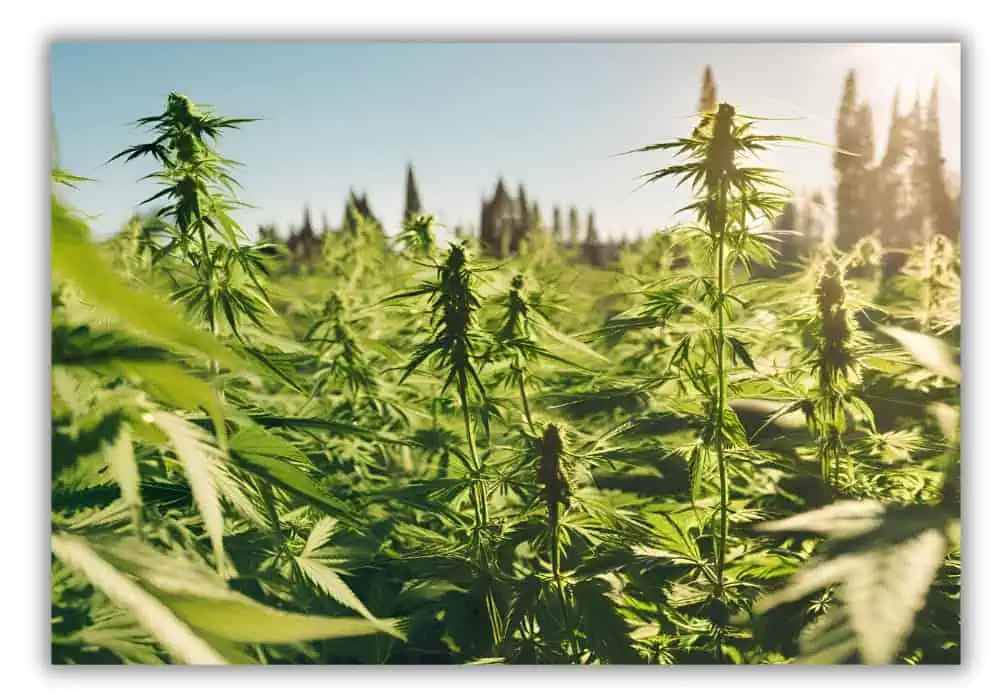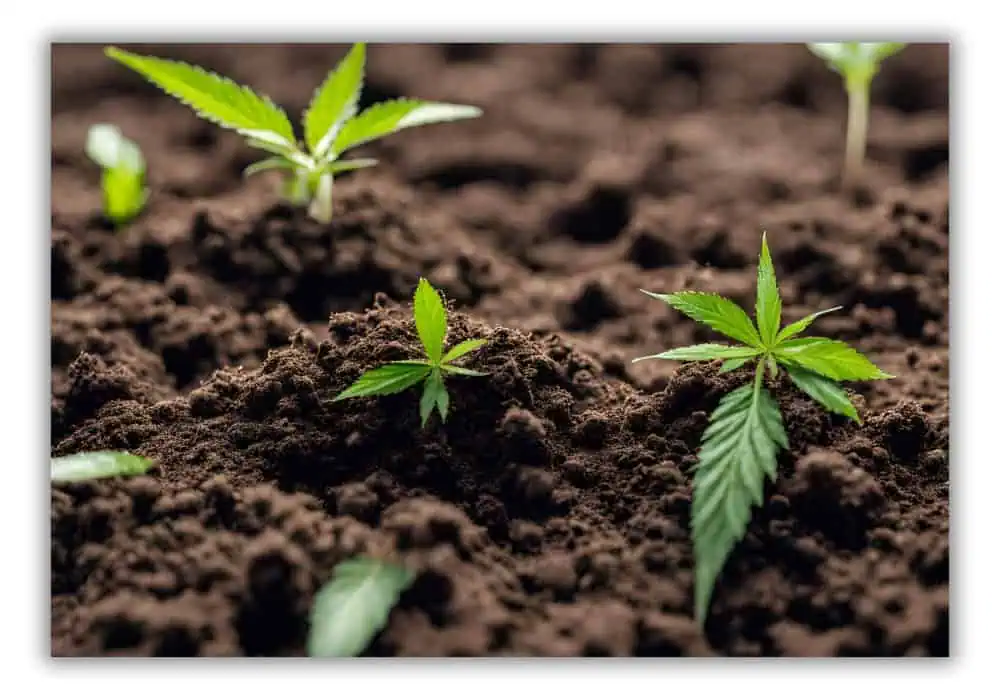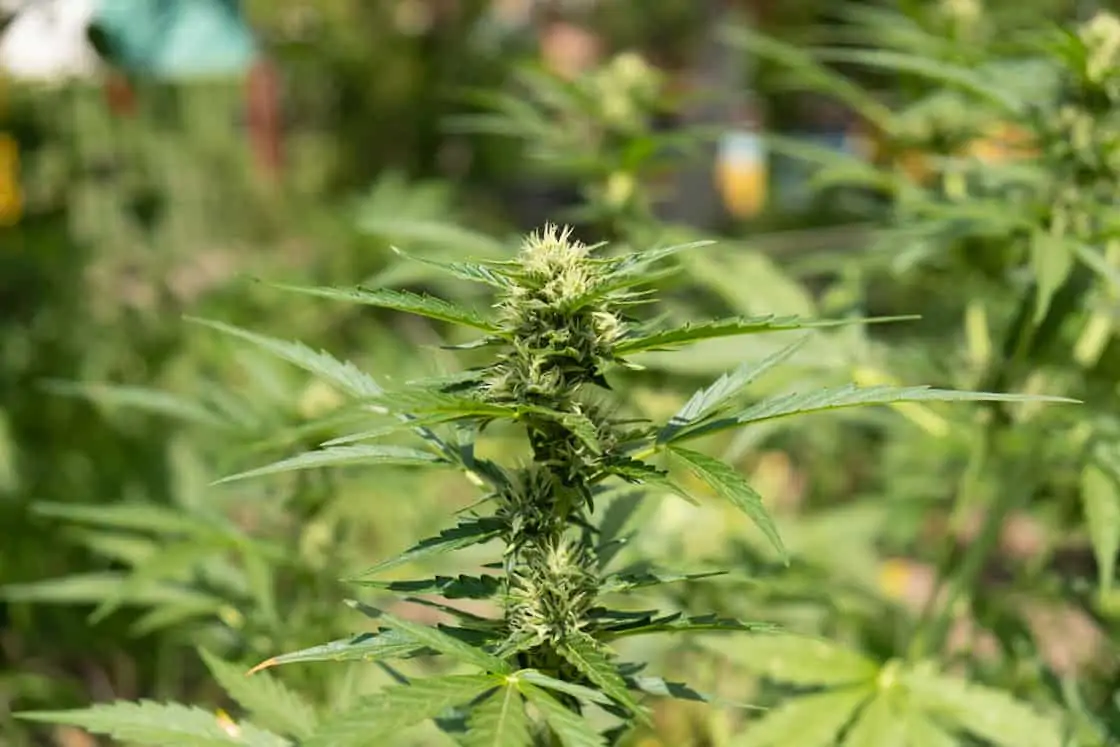TABLE OF CONTENTS
Our guide to growing weed outdoors gives you a detailed rundown of the cannabis cultivation process.
Whether you're planting an open-air or greenhouse garden, growing cannabis outdoors can produce a bountiful yield with flavorful and aromatic flower buds.
Here's everything you need to know about growing weed outdoors.
Benefits of Growing Weed Outdoors
Outdoor cannabis has long been compared unfavorably to indoor weed, which is seen as the most potent and flavorful available.
Despite this misconception, outdoor-grown weed can boast a fuller spectrum of cannabinoids and terpenes than indoor weed.
Consider the high energy costs of artificial lights, air conditioning, and dehumidifiers inside an indoor growing space.
When growing outdoors, you rely on the natural power of the sun to stimulate root, leaf, and bud growth. All you need is good soil, fertilizer, and seeds.
Indoor growing spaces are usually limited in size. Outdoor spaces, however, give your plants plenty of room to grow roots and plants as tall and wide as they please. Large plants mean a bountiful harvest of up to a pound of weed per plant.
As mentioned above, indoor gardens require high energy costs, which can be wasteful for some people.
Outdoor gardens are seen as a more environmentally-friendly approach that doesn’t waste electricity. Instead, the energy is derived from the free sunlight.

Most importantly, outdoor cannabis growing is a fun and relaxing pastime. Gardening, in general, can be a meditative experience that allows you to literally reap the fruits of your labor.
What could be better than smoking some of your freshly-cured flower buds?
Step 1: Plan Ahead When Growing Cannabis Outdoors
Planning ahead is essential to achieve the best results from your outdoor-grown cannabis.
Here are a few factors to consider before growing weed plants outdoors.
Climate Considerations When Growing Weed Outdoors
Climate plays a crucial role in planning your outdoor cannabis cultivation. While cannabis has adapted to grow in nearly every environment, harsh conditions can still cause damage and even lead to death. Ideally, temperatures should be between 75º and 85º F.
Consistent temperatures above 86º F can stall growth, while temperatures below 55º F can cause stunted growth and death.
In terms of environmental stressors, heavy rains and strong winds can wreak havoc on your crop. Furthermore, extremely humid environments can be a breeding ground for moisture and powdery mildew.
Also, consider the length of daylight your area gets if you are growing photoperiod strains.
Some areas of the world receive more hours of daylight on the same day.
Choosing a Location and Space For Growing Weed Outdoors

Ideally, you’ll want to plant or place your cannabis in areas that receive the most amount of light, especially during mid-day when the sun is in full force.
Consider the privacy and security needs of your garden. Most states with legal cannabis require you to conceal your cannabis garden from neighbors. A tall fence, tree, or other foliage could help seclude your area.
Planting in balconies or rooftops could keep your grow under wraps. In terms of security, a strong cage or fence could keep thieves and pests out.
Finally, ensure your outdoor weed grow is allowed by your local laws and it is secured and not visible or accessible to the public.
Choosing the Right Genetics For Growing Weed Outdoors
Choosing a cannabis strain is one of the most exciting parts of the process. Consider your strain’s unique growing characteristics. Does your strain grow well in your climate and location? Look up strain reviews and tips from growers on which strains prefer which growing conditions.
Furthermore, you’ll have to choose between seeds and clones to grow. Seeds can grow a heartier taproot compared to clones, but you risk ending up with a male or a different phenotype than you’d like.
Clones, which are cuttings from a mother plant during its vegetative state, can be bought from a licensed dispensary. Watch out, though, because clones can inadvertently introduce pests and disease into your garden if you’re not careful.
Autoflowering strains are a good choice for gardeners who want a fast-growing crop or those who want multiple harvests throughout the year.
Autoflowering strains begin to bloom automatically after a few weeks instead of waiting for a specific sunlight period. The only downside is that these strains can be less potent. Growing weed outdoors that is potent may work better with strains that are not auto-flowering.
Soil For Growing Weed Outdoors

Soil is a crucial part of the equation that holds the moisture and nutrients necessary for growth. Soil pH is important because extremely high or low levels could restrict nutrient uptake.
You can check your own pH and make the necessary amendments to get your plant back on track to a healthy state.
Soil consistency is a major element of the soil’s quality. Cannabis plants thrive in loamy soil, which is soil that consists of sand and silt and some clay.
Too much clay can reduce oxygen levels for roots. Sandy and silty soil offer a good mix of drainage, warmth, and nutrient lockdown.
Ensure your soil fertility allows for a healthy and diverse microbiome that helps your cannabis plants grow big and bountiful.
Nutrients For Growing Weed Outdoors
Fertilizer full of nutrients is an essential part of a cannabis plant throughout its life.
The three main nutrients a cannabis plant uses are nitrogen, phosphorus, and potassium. Beginners can stick with nutrient solutions made specifically for cannabis.
DIY or pre-made organic fertilizers are made of things like blood meal, bat guano, kelp meal, which is helpful for healthy microbe diversity.
Water For Growing Weed Outdoors

Rain and groundwater can be beneficial to outdoor plants and saves you time and money on watering. Too much of it, however, can be detrimental to the plant.
Check your plants regularly and water them consistently when it gets too hot during the summer. Some large cannabis plants can use up to 10 gallons of water per day.
Ideally, use filtered water to reduce the number of dissolved minerals in your soil.
Tap water can contain high levels of these that can affect the soil’s pH level. Water your plants if the top couple of inches is dry.
If you have a rainy climate, you’ll need to improve drainage. Try planting in raised beds or diverting the water through ditches. If water retention is a problem, add clay, rocks, or other materials to improve retention.
Step 2: Germination of Weed
If you're starting from seeds, you have to germinate your seeds first. One of the most effective ways to germinate your cannabis seeds is using a moist starter cube/plug and a heat mat.
However, one of the easiest ways to germinate your seeds is through the paper towel method using the following:
- Cannabis seeds
- Paper towels
- Two plates
- Water
Find step-by-step instructions on how to germinate seeds using the paper towel method on our blog resource.
Step 3: Vegetative Stage of Weed
Once your seeds have sprouted and cotton their first leaves, this is when the vegetative stage begins.
From spring until fall, the vegetative phase uses sunlight and nutrients to grow its roots, leaves, and stems. During this stage, your cannabis plans will need higher levels of nitrogen to fuel their growth.
During this stage, you can experiment with different cannabis training techniques including low-stress and high-stress techniques. In addition, make sure you're closely monitoring your plants water intake.
As it grows bigger, it will need more water. Make sure to water your weed plants away from the stalk to allow your roots to stretch out.
Step 4: Flowering Stage of Weed

Here's where it gets exciting. The flowering stage is when your plants begin to grow their resinous flower buds that we all know and love.
Generally, you'll be growing photoperiod plants which require a 12-12 light schedule of lightness and darkness.
Autoflowering plants don't flower according to a light cycle. Instead, they begin flowering after a certain period of time.
If you're growing from regular cannabis seeds, this is where it gets tricky. Feminized weed seeds are most likely going to yield female flowering plants.
During the flowering stage, you've got to keep an eye on your plants grown from regular seeds since there's a possibility that you may end up with a male pollinating plant.
Male plants grow pollen sacs without the tall-tale white hair pistils of female plants. Make sure to remove the male plants immediately to avoid pollinating females and ruining your crop.
Make sure to pay close attention to the status of your flowering plants since they may require fine-tuning with nutrients and pruning due to the focus being spent on the bud growth.
Some cannabis growers choose to flush their crops before harvest. Flushing involves feeding plants only water to remove the nutrients from the plants right before the harvest.
Step 5: Harvest for Weed
After many months of carefully tending to your plants, it's time to harvest your crop. But, how do you know when your buds have reached their peak freshness?
Here are some guidelines to consider to perfectly time you are harvest:
- Pay attention to your senses. Your garden should be very pungent and feature bud sites with tons of trichomes that start off as white, hair-like glands.
- Allow about half of the trichomes to darken over time to a golden-yellow color signaling higher cannabinoid levels.
- Allow about two-thirds of the trichomes to darken for a more sedating and anti-anxiety experience due to the THC content converting to the calming CBN.
- If possible, use a magnifying glass or loupe to assess the color and formation of your trichomes.
It takes a bit of trial and error to perfectly time your harvest, especially if you have trouble estimating the color and percentage of trichomes that have changed.
Over time, it gets easier. Now, it's time to sanitize your scissors, and start cutting the plant down to begin the final stages.
Step 6: Drying Weed

After you cut down your cannabis branches and have trimmed off the excess leaves and foliage from the buds, it's time for the drying stage. Drying takes place in a cool, dry, and dark area.
“
There are over 300,000 jobs in the cannabis industry. CTU trained me for one of them!

Makes $24.50 @ THC +
Growers generally hang the branches (using clothes hangers or similar tools) upside down for them to dry out. An ideal drying environment is about 70º F with 50% humidity.
Drying your buds is a slow process that requires patience. Allow your buds to dry until they feel dry to the touch and their small stems produce an audible snap sound when bent.
Thicker stems may usually bend slightly. When they’re fully dry, it’s time to move on to the curing stage.
Step 7: Curing Weed
Curing cannabis is a similar concept to drying it, which removes the excess moisture. However, curing takes place in an airtight mason jar in a dark and cool location.
Simply fill your mason jar about 3/4 of the way full and allow your buds to sit there for a few weeks.
Every day, open the jar for a few minutes to allow your buds to get fresh air and the moisture to be released. Excess moisture can lead to mold which can ruin your flower.
When your buds start to feel dry when you open them after a week or two, you can open the lid fewer times (about once a week).
Curing timelines vary by grower. You will need to experiment to find your preferred curing length.
Step 8: Storage for Weed
Once you've harvested your trichome-laden buds, the work's not done, although it gets much easier from here.
If you're looking to store your flower buds for the long-term and preserve their freshness, consider your storage practices to avoid a reduction in potency, flavor, and aroma. Here are a few tips for the keeping your weed buds fresher for longer:
- Humidity packs: If possible, add a humidity pack into your bud jar. These moisture-balancing packs absorb or release moisture as needed. Humidity packs are available in a range of relative humidity levels between 58% or 62% humidity depending on your environment.
- Airtight containers: Invest in an airtight mason jar or other airtight containers to store your flower. Ideally, stick with glass or ceramic over plastic. Vacuum bags can also work.
- Dark environment: Heat, moisture, oxygen, and lights all can age your weed. Ideally, invest in a container that is opaque or UV protected. Light entering the bud jar can reduce the potency and quality of your buds. In addition, keep your weed storage area dark, as well.
- Cool environment: Keep your weed storage area under 78° F to reduce the risk of mold in your bud jar.

Luis Cordova
Luis Cordova is a distinguished author, and renowned expert in cannabis cultivation, who possesses a Master's degree in Plant Biotechnology and Pharmaceutical Science. As a valued contributor to highly esteemed publications such as Cannabis Training University and Maximum Yield Magazine, Luis has emerged as a trusted source of guidance and knowledge in the cannabis industry. Having written thousands of informative articles, Luis is widely recognized for his comprehensive expertise on cultivating cannabis, both indoors and outdoors.












 Jeff was involved in an accident where he endured a traumatic brain injury. He had a week-long stay in ICU where brain surgeons
Jeff was involved in an accident where he endured a traumatic brain injury. He had a week-long stay in ICU where brain surgeons  100% risk free money back guarantee within 48 hours after purchase if student has not completed any of the courses or exams.
100% risk free money back guarantee within 48 hours after purchase if student has not completed any of the courses or exams.